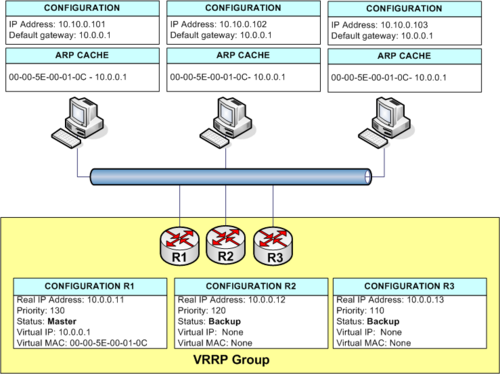Virtual Router Redundancy Protocol
Like HSRP, Virtual Router Redundancy Protocol (VRRP) allows a group of routers to form a single virtual router. In an HSRP or VRRP group, one router is elected to handle all requests sent to the virtual IP address. With HSRP, this is the active router. An HSRP group has one active router, at least one standby router, and perhaps many listening routers. A VRRP group has one master router and one or more backup routers. The LAN workstations are then configured with the address of the virtual router as their default gateway.
VRRP differs from HSRP in the following ways:
- VRRP is an IEEE standard (RFC 2338) for router redundancy
- HSRP is a Cisco-proprietary protocol.
- The virtual router represents a group of routers, known as a VRRP group or virtual router group.
- The active router is referred to as the master virtual router.
- The master virtual router may have the same IP address as the virtual router group.
- Multiple routers can function as backup routers.
- VRRP is supported on Ethernet, Fast Ethernet, and Gigabit Ethernet interfaces, and with Multiprotocol Label Switching (MPLS), virtual private networks (VPNs), and VLANs.
Contents
Purpose of HSRP
The purpose of HSRP is to ensure network connectivity in case of Router or access circuit failure, by having one or more standby Router(s) waiting to take over from the failing active Router.
Other high availability Router protocols
How does VRRP workVRRP works by two or more Routers agreeing upon which Router serves the virtual Router. The Virtual RouterThe Virtual Router is a MAC-address and a IP Address the master Router serves beside its configured IP address. If the master Router fails one of the backup Routers becomes the Virtual Router by serving the virtual MAC-address and IP Address. VRRP exampleIn picture 1 three Routers R1,R2 and R3 are setup in a VRRP Group. The Virtual IP address 10.0.0.1 and virtual MAC-Address 00-00-5E-00-01-0C are served by the master Router R1. R1 continuesly transmits hello packets to the backup Routers. |
Configuration of R1, R2 and R3
hostname R1 ! interface FastEthernet1/0 ip address 10.0.0.11 255.0.0.0 vrrp 10 priority 130 vrrp 10 ip 10.0.0.1 |
hostname R2 ! interface FastEthernet1/0 ip address 10.0.0.12 255.0.0.0 vrrp 10 priority 120 vrrp 10 ip 10.0.0.1 |
hostname R3 ! interface FastEthernet1/0 ip address 10.0.0.13 255.0.0.0 vrrp 10 priority 110 vrrp 10 ip 10.0.0.1 |
